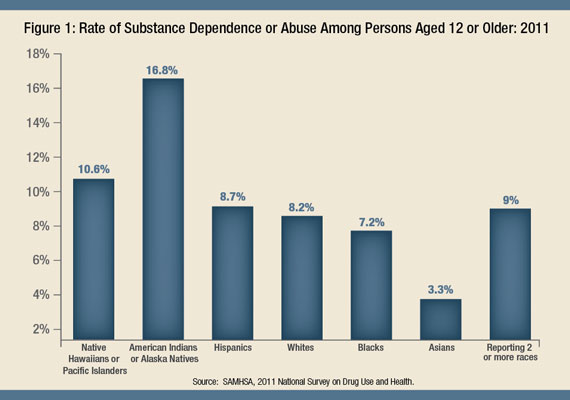Addressing Substance Use in Tribal Communities

Alcoholism and addiction are among the most severe public health problems facing American Indian and Alaska Native people. According to SAMHSA's 2011 National Survey on Drug Use and Health (NSDUH), the rate of substance dependence or abuse among American Indians or Alaska Natives age 12 or older was twice that of other ethnic backgrounds (See Figure 1). The rate of current heavy alcohol use among this population was the highest at 11.6 percent. To address these issues, and in accordance with the Tribal Law and Order Act (TLOA)  , SAMHSA has created the Office of Indian Alcohol and Substance Abuse (OIASA).
, SAMHSA has created the Office of Indian Alcohol and Substance Abuse (OIASA).
As directed by Congress through TLOA, SAMHSA has taken a lead role in establishing OIASA and coordinating efforts among the U.S. Department of Health and Human Services (HHS), the Department of the Interior (DOI), and the Department of Justice (DOJ). President Obama signed TLOA into law in July 2010. The law requires a significant amount of interagency collaboration in order to build upon previous efforts that address alcohol and substance abuse in Indian Country as well as create a sustainable model for the future.
In July 2011, a Memorandum of Agreement was signed by HHS Secretary Kathleen Sebelius, DOI Secretary Ken Salazar, and Attorney General Eric Holder. The agreement outlined how OIASA will coordinate tribal substance abuse programs across the Federal Government with special emphasis on promoting programs geared toward reaching youth and offering alternatives to incarceration.

Today, OIASA is offering technical assistance to Tribal governments that need help in developing their Tribal Action Plans (TAP). The TAP coordinates resources and programs to assist Tribes in achieving their goals in the prevention, intervention, and treatment of alcohol and substance abuse.
Rod Robinson joined SAMHSA as the new Director of OIASA in September. Mr. Robinson has been working with Tribes throughout the United States and Canada in the areas of substance abuse prevention, intervention, treatment, and strategic planning for over 30 years and is an enrolled member of the Northern Cheyenne tribe in Montana. "With the enactment of the Tribal Law and Order Act of 2010," said Mr. Robinson, "the Tribes and Congress very wisely created a Tribal Action Planning process as a dynamic opportunity to gain greater justice, safety, and wellness in Indian Country."
With a structure in place for the Federal Government to work holistically with Tribal Communities through OIASA, Mr. Robinson said that momentum is building. Tribes have elevated their level of commitment to how they are going to address substance use and treatment within their communities. He also emphasized the importance of respecting local leadership and culture throughout this process. "Tribes want to find a real solution," said Mr. Robinson. "OIASA is committed to continuing to ensure that a tribal perspective is considered in the process of developing interdepartmental cooperation."
For more information about OIASA and TLOA including resources to download, visit www.samhsa.gov/TLOA.